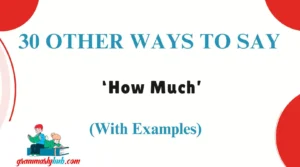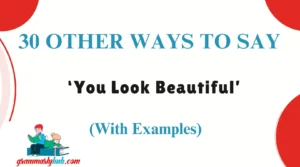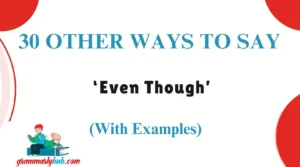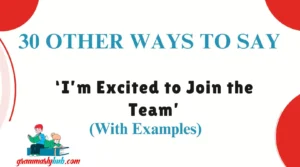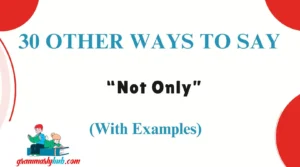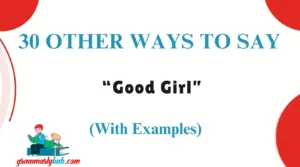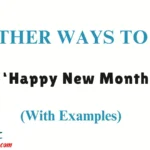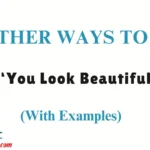Finding the right transitional phrase can make your writing feel more personal, polished, and meaningful. “With that being said” is a common way to introduce a contrasting idea, move forward, or gently shift focus—but using it repeatedly can feel repetitive or mechanical. In both spoken and written communication, having thoughtful alternatives helps you express ideas with clarity, warmth, and variety.
This article offers 30 unique and expressive ways to say “with that being said,” along with definitions, use cases, tone, and examples for each. Whether you’re writing an email, an essay, or a speech, these alternatives will help you sound natural, intelligent, and empathetic.
What Does “With That Being Said” Mean?
“With that being said” is a transitional phrase used to introduce a new point—often one that contrasts with or adds nuance to what was just mentioned. It’s a polite way to pivot the conversation or draw attention to a next step, reflection, or consideration.
When to Use “With That Being Said”
Use it when:
- You’re changing direction slightly or offering a different perspective
- You want to acknowledge something before adding a conclusion or decision
- You’re trying to soften or cushion a contrast or contradiction
Is It Professional/Polite to Say “With That Being Said”?
Yes, it’s generally polite and professional, especially in writing. However, in formal or creative settings, it can feel overused. Choosing a more tailored phrase can make your writing or speech more engaging and polished.
Pros and Cons of Saying “With That Being Said”
Pros:
- Clear and respectful
- Widely understood
- Smoothly transitions between ideas
Cons:
- Can feel repetitive or cliché
- Slightly passive in tone
- Less precise than other transitions
“With That Being Said” Synonyms
- That said
- Having said that
- Even so
- Nonetheless
- Nevertheless
- Still
- Yet
- Regardless
- Be that as it may
- Even though that’s true
- All the same
- Despite that
- While that may be the case
- On the other hand
- At the same time
- Though that’s worth noting
- But still
- That being acknowledged
- Taking that into account
- Considering that
- Let’s move on
- Now, moving forward
- Let’s shift gears
- Turning to the next point
- To follow up on that
- Building on that
- Following that logic
- In contrast
- However
- In any case
1. That Said
Definition: A shorter, more conversational way to signal a contrasting or follow-up point.
Detailed Explanation: It’s often used in both spoken and written English to pivot or slightly shift direction while maintaining flow.
Example: “The product performed well during testing. That said, we still need to address several usability concerns.”
Worst Use: In very formal academic writing, where full transitional phrases may be preferred.
Tone: Conversational, polished.
2. Having Said That
Definition: A polite, reflective phrase used to acknowledge something before offering a caveat or new angle.
Detailed Explanation: This phrase carries a slightly formal tone and suggests careful thought.
Example: “The report offers strong insights. Having said that, it could benefit from more recent data.”
Worst Use: In quick, informal conversations—it may sound too formal.
Tone: Respectful, balanced.
3. Even So
Definition: Used to introduce an exception or contrast despite the previous statement.
Detailed Explanation: A powerful way to show that what comes next is unexpected or worth considering.
Example: “He lacks experience. Even so, his passion and work ethic are impressive.”
Worst Use: When the contrast isn’t strong or relevant.
Tone: Emphatic, thoughtful.
4. Nonetheless
Definition: Signals a contrast or exception while maintaining a formal, refined tone.
Detailed Explanation: Ideal in essays or reports where you want to sound analytical.
Example: “There are budget constraints. Nonetheless, the project must move forward.”
Worst Use: In casual conversations—it can sound stiff.
Tone: Formal, assertive.
5. Nevertheless
Definition: A formal synonym of “nonetheless,” often used in writing to maintain a professional tone.
Detailed Explanation: Suggests a deliberate shift, often introducing something slightly surprising.
Example: “The team is small. Nevertheless, we met all our deadlines.”
Worst Use: When a softer, more conversational tone is needed.
Tone: Formal, composed.
6. Still
Definition: A simple, subtle way to introduce a mild contrast or continuation.
Detailed Explanation: Works well in friendly, informal tones.
Example: “It was a long day. Still, we managed to get everything done.”
Worst Use: In academic or business writing—too casual.
Tone: Easygoing, neutral.
7. Yet
Definition: A compact way to show contrast, especially in persuasive or narrative writing.
Detailed Explanation: It suggests tension or complexity between two ideas.
Example: “The weather was terrible. Yet, we enjoyed every moment of the trip.”
Worst Use: When more explanation or emphasis is needed.
Tone: Literary, expressive.
8. Regardless
Definition: Used to signal that the next point holds true despite the previous one.
Detailed Explanation: Offers a firm stance, often in decisions or conclusions.
Example: “Some staff are hesitant. Regardless, the change will be implemented next week.”
Worst Use: In sensitive discussions—can feel dismissive.
Tone: Strong, determined.
9. Be That as It May
Definition: An old-fashioned but elegant way to say “even though that’s true.”
Detailed Explanation: It adds a formal, rhetorical flair to writing or speeches.
Example: “The proposal has merit. Be that as it may, it lacks financial feasibility.”
Worst Use: In modern, informal communication—it may sound outdated.
Tone: Formal, poetic.
10. Even Though That’s True
Definition: A clear, gentle way to acknowledge and then contrast with a previous point.
Detailed Explanation: Good for making nuanced arguments or offering respectful disagreement.
Example: “Even though that’s true, we still need to verify the source before we proceed.”
Worst Use: In brief summaries—it’s a longer phrase.
Tone: Empathetic, diplomatic.
11. All the Same
Definition: Used to introduce something that remains true despite previous information.
Detailed Explanation: Conveys a sense of acknowledgment followed by subtle disagreement or contrast.
Example: “He apologized sincerely. All the same, the damage was already done.”
Worst Use: In formal legal or technical writing—can feel vague.
Tone: Polite, mild.
12. Despite That
Definition: A clean, direct way to transition into a point that contrasts with the previous one.
Detailed Explanation: Best for formal or written communication that needs precision.
Example: “The timeline was tight. Despite that, the team delivered exceptional work.”
Worst Use: When transitioning into a soft or uncertain idea.
Tone: Confident, professional.
13. While That May Be the Case
Definition: Introduces a thoughtful shift, especially when balancing perspectives.
Detailed Explanation: Useful in debates, discussions, or nuanced writing where you want to show fairness.
Example: “While that may be the case, the data tells a different story.”
Worst Use: In overly casual messages—can sound too formal or hesitant.
Tone: Reflective, balanced.
14. On the Other Hand
Definition: Offers a contrasting point or perspective directly.
Detailed Explanation: A familiar and effective way to explore different sides of a topic.
Example: “Working from home saves time. On the other hand, it can affect collaboration.”
Worst Use: If only one viewpoint is being shared—requires a setup.
Tone: Structured, fair.
15. At the Same Time
Definition: A smooth way to show coexistence of two seemingly conflicting ideas.
Detailed Explanation: Implies balance without forcing a contradiction.
Example: “We want to grow quickly. At the same time, we must preserve our company culture.”
Worst Use: When a strong pivot or opposition is needed.
Tone: Collaborative, careful.
16. Though That’s Worth Noting
Definition: A softer acknowledgment before redirecting to a more pressing point.
Detailed Explanation: Works well in advisory or persuasive writing.
Example: “Though that’s worth noting, our focus right now is on long-term goals.”
Worst Use: In technical documentation or instructions.
Tone: Thoughtful, guiding.
17. But Still
Definition: A casual way to express slight contradiction or reservation.
Detailed Explanation: Works best in conversational tone or emails.
Example: “He’s new to the team, but still, his feedback was incredibly helpful.”
Worst Use: In professional or academic settings—may feel too relaxed.
Tone: Informal, sincere.
18. That Being Acknowledged
Definition: Formal and respectful phrasing to transition into an alternate view.
Detailed Explanation: Suitable when you need to validate something before presenting an important counterpoint.
Example: “That being acknowledged, we must consider other contributing factors.”
Worst Use: In casual emails or conversations—it may sound too stiff.
Tone: Respectful, formal.
19. Taking That Into Account
Definition: Indicates careful consideration before moving forward with a related point.
Detailed Explanation: Often used in decision-making or analytical writing.
Example: “Taking that into account, we’ve adjusted the project timeline accordingly.”
Worst Use: When a quick, emotional response is needed.
Tone: Practical, deliberate.
20. Considering That
Definition: A concise and neutral way to show that you’re making a point based on prior information.
Detailed Explanation: Good for emails, essays, or memos where logic is central.
Example: “Considering that, we believe a phased approach is more appropriate.”
Worst Use: When emotional connection is more important than logic.
Tone: Logical, composed.
21. Let’s Move On
Definition: A simple phrase used to transition away from the current topic.
Detailed Explanation: Best used when the previous point has been acknowledged and it’s time to progress.
Example: “We’ve addressed that concern thoroughly. Let’s move on to the next agenda item.”
Worst Use: In emotionally sensitive conversations—it may feel dismissive.
Tone: Direct, efficient.
22. Now, Moving Forward
Definition: Signals a forward-looking approach after reflecting on something.
Detailed Explanation: Great for shifting focus toward action, progress, or a new perspective.
Example: “We learned a lot from that experience. Now, moving forward, we’ll take a more cautious approach.”
Worst Use: When contrast—not progression—is needed.
Tone: Motivational, optimistic.
23. Let’s Shift Gears
Definition: A casual and friendly way to change the subject or approach.
Detailed Explanation: Often used in presentations, conversations, or team meetings.
Example: “We’ve covered the challenges. Let’s shift gears and focus on solutions.”
Worst Use: In formal or academic writing.
Tone: Conversational, relaxed.
24. Turning to the Next Point
Definition: A formal and smooth transition to a new idea or topic.
Detailed Explanation: Ideal for structured discussions, documents, or presentations.
Example: “That concludes the financial overview. Turning to the next point, let’s discuss marketing.”
Worst Use: In emotional or casual conversations—it may sound robotic.
Tone: Organized, formal.
25. To Follow Up on That
Definition: A soft, responsive transition that builds on what was just discussed.
Detailed Explanation: Best used when continuing or expanding on a previous idea.
Example: “To follow up on that, we’ve developed a timeline for implementation.”
Worst Use: When the next idea contradicts the first rather than expanding it.
Tone: Supportive, fluid.
26. Building on That
Definition: Suggests that the next idea extends or supports the previous one.
Detailed Explanation: Great for collaborative settings or progressive writing.
Example: “Building on that, we’ve identified new opportunities in the market.”
Worst Use: When introducing a contradiction—it might confuse the listener.
Tone: Collaborative, constructive.
27. Following That Logic
Definition: Indicates a reasoned progression or inference based on what was said.
Detailed Explanation: Excellent for persuasive writing or analytical presentations.
Example: “Following that logic, it makes sense to delay the launch.”
Worst Use: In emotional or narrative storytelling—can sound cold or technical.
Tone: Logical, reasoned.
28. In Contrast
Definition: A clear signal that what comes next will oppose or differ from what was just mentioned.
Detailed Explanation: Ideal for comparisons, debates, or analytical writing.
Example: “Team A focused on speed. In contrast, Team B prioritized quality.”
Worst Use: When transitioning into a soft or aligned point.
Tone: Sharp, objective.
29. However
Definition: A strong and universally understood way to indicate contradiction or nuance.
Detailed Explanation: One of the most flexible transitional phrases used in professional and academic writing.
Example: “The policy has good intentions. However, its impact may be limited.”
Worst Use: Overuse can make writing sound stiff or overly critical.
Tone: Formal, analytical.
30. In Any Case
Definition: A relaxed way to move forward, often used to dismiss minor issues or wrap up.
Detailed Explanation: Implies that regardless of the previous point, the next one still holds.
Example: “It may not be perfect. In any case, we’re moving forward with the plan.”
Worst Use: When trying to maintain emotional connection—it can sound indifferent.
Tone: Dismissive, light.
Conclusion
“With that being said” is a useful phrase—but with variety comes clarity, and with the right word comes connection. Whether you’re writing to express contrast, pivot a conversation, or gently guide your reader forward, these 30 warm, professional, and expressive alternatives help you do it with care and confidence.
Use them to make your writing feel more intentional, personal, and thoughtful—and your voice will always resonate clearly.

Welcome to GrammarlyHub, your go-to destination for mastering grammar, improving your writing, and finding the best language tools available online. Founded by Emma Rose, a passionate writer and advocate for clear communication, GrammarlyHub was built to help people express themselves with confidence and accuracy.


